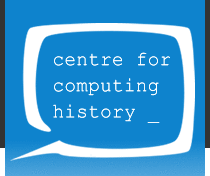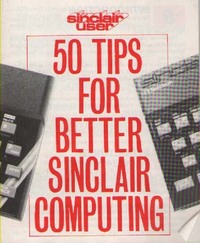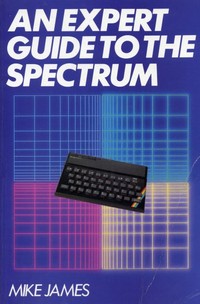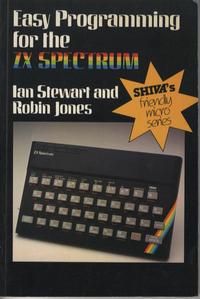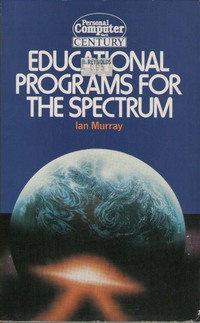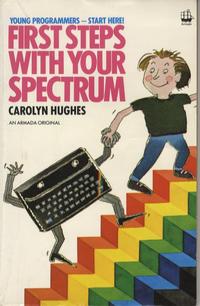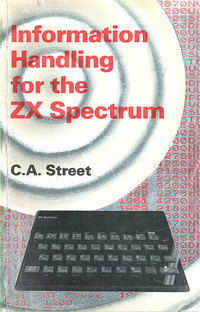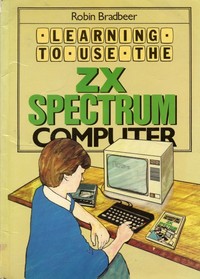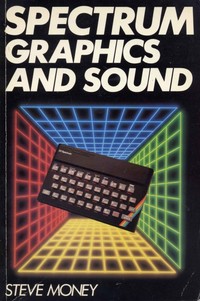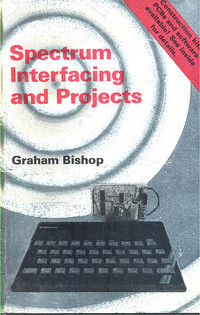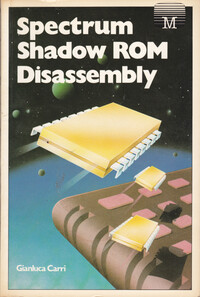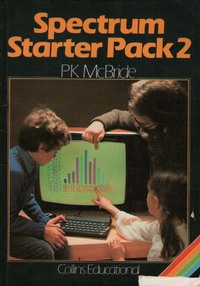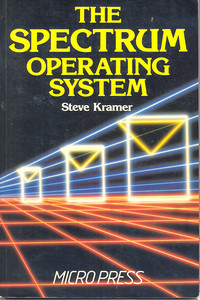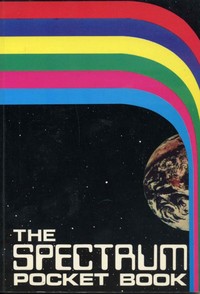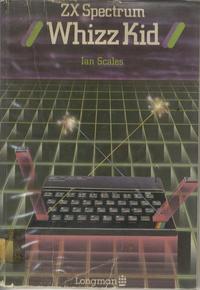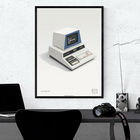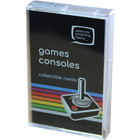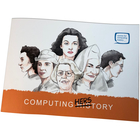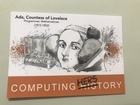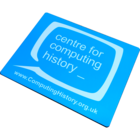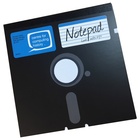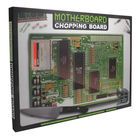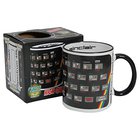ZX Spectrum Books
The following is a list of ZX Spectrum Books in the Centre for Computing History collection. It is not an exhaustive list of and other books may have been published. If you have a book that you would like to donate to our collection, please view our donations page.There are 87 ZX Spectrum Books in our collection :
| Order By : Title - Release Date - Publisher |
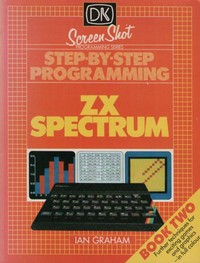 Date: 1984
Step-By-Step Programming ZX Spectrum Book Two
Date: 1984
Step-By-Step Programming ZX Spectrum Book Two
Publisher: Dorling Kindersley
Author: Ian Graham
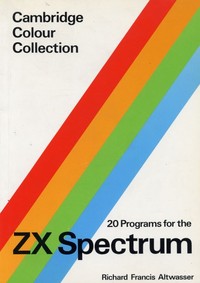 Date: 1982
20 Programs for the ZX Spectrum
Date: 1982
20 Programs for the ZX Spectrum
Publisher: Cambridge Colour Collection
Author: Richard Francis Altwasser
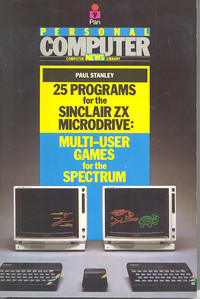 Date: 1984
25 programs for the Sinclair ZX Microdrive
Date: 1984
25 programs for the Sinclair ZX Microdrive
Multi-user Games for the Spectrum
Publisher: Pan / Personal Computer News
Author: Paul Stanley
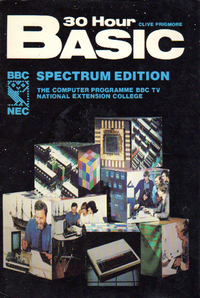 Date: 1983
30 Hour Basic - Spectrum Edition
Date: 1983
30 Hour Basic - Spectrum Edition
Publisher: National Extension College
Author: Clive Prigmore
 Date: 1983
40 Best Machine Code Routines for the ZX Spectrum
Date: 1983
40 Best Machine Code Routines for the ZX Spectrum
From back cover:
This book teaches the beginner by example in a simple, easy to learn form and it is an invaluable reference work for the expert too.
Second Edition June 1983
Publisher: Hewson Consultants
Author: John Hardman, Andrew Hewson
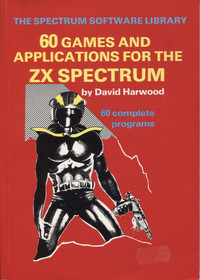 Date: September 1983
60 Games and Applications for the ZX Spectrum
Date: September 1983
60 Games and Applications for the ZX Spectrum
"David Harwood has brought together an exciting collection of games and utility programs for the ZX Spectrum, all presented in ready-to-run form. And because every program has been dumped directly onto the ZX Printer, we know you'll have no problems getting them up and running within seconds of typing them in."
Publisher: Interface Publications
Author: David Harwood
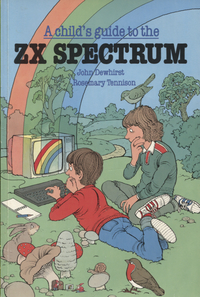 Date: 1983
A Child's Guide to the ZX Spectrum
Date: 1983
A Child's Guide to the ZX Spectrum
Publisher: Cambridge University Press
Author: John Dewhirst Rosemary Tennison
 Date: January 1984
A Pocket Handbook for the Spectrum
Date: January 1984
A Pocket Handbook for the Spectrum
This book was kindly donated by Rodney Dale
Publisher: Gerald Duckworth & Co Ltd
Author: Peter Gerrard, Danny Doyle
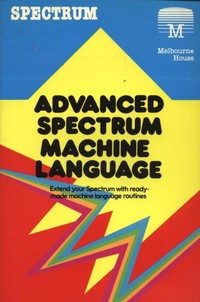 Date: 1984
Advanced Spectrum Machine Language
Date: 1984
Advanced Spectrum Machine Language
Advanced Spectrum Machine Language
This book is a collection of ready-made machine language routines that show how to archieve spectacular effects on the Spectrum. Most of the routines are aimed at creating visual displays that are at the frontiers of Spectrum's capabilities. The routines include features that have never been published before, such as: Full Screen Horizon ! Lets you change the colour of the border and screen at any point, and move this horizon at will ! Interrupts Driven Sprite Animation ! Animate objects with perfectly flicker-free movement by pixels ! High Resolution Colour ! Create an area on the Spectrum with eight times the normal Spectrum's Colour Resolution! Create images over all of the screen area, including all regions of the border !
This book is for programmers with some experience in machine language programming. All the routines are listed in labelled assembly language and the techniques and principles involved are fully explained. Other routines included in this book are PRINT, PLOTTING, DRAWNING and KEYBOARD SCAN. The routines are all of professional quality and do no involve any calls to the ROM. This means that the speed of your machine language programs can be dramatically increased using these routines.
Publisher: Melbourne House
Author: David Webb
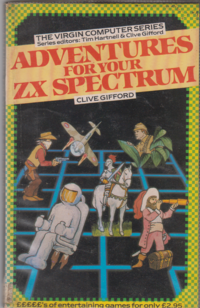 Date:
Adventures for your ZX Spectrum
Date:
Adventures for your ZX Spectrum
Hours and hours of mind-stretching adventure games.
Publisher: Virgin Books
Author: Clive Gifford
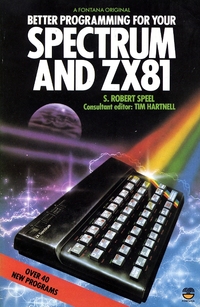 Date: 1983
Better Programming for your Spectrum and ZX81
Date: 1983
Better Programming for your Spectrum and ZX81
The book teaches you better programming techniques and will help you get the very best from your computer.
Publisher: Fontana Original
Author: S. Robert Speel
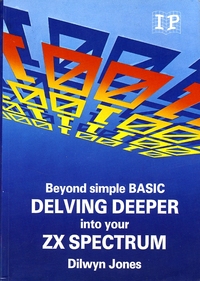 Date: 1983
Beyond Simple BASIC Delving Deeper into your ZX Spectrum
Date: 1983
Beyond Simple BASIC Delving Deeper into your ZX Spectrum
When you've mastered introductory programming on the spectrum, you need this outstanding guide to enhanced programming techniques and concepts.
Publisher: Interface Publications
Author: Dilwyn Jones
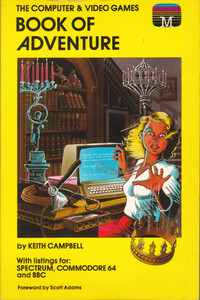 Date: 1983
Book of Adventure
Date: 1983
Book of Adventure
Forewood by Scott Adams, a master of the text adventure, this title leads the reader through the various facets of adventure games, including the history of adventure games and a hall of fame.
Also has a clear explanation of programming techniques, including how to introduce objects, and all the other skills to produce an exciting text adventure.
Publisher: Melbourne House
Author: Keith Campbell
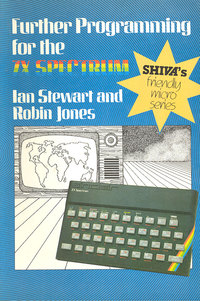 Date: 1983
Further Programming for the ZX Spectrum
Date: 1983
Further Programming for the ZX Spectrum
This sequel to Easy Programming helps you to get more out of your ZX Spectrum computer. An original selection of programs and applications needing only 16K of memory, and so can be RUN on either model of the Spectrum.
Publisher: Shiva Publishing Limited
Author: Ian Stewart and Robin Jones
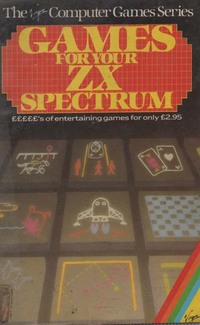 Date: March 1983
Games For Your ZX Spectrum
Date: March 1983
Games For Your ZX Spectrum
The Virgin Computer Games Series
Classifications
Dewey Decimal Class 794.8/028/5425
Library of Congress GV1469.2
ID Numbers
Open Library OL20032712M
OCLC/WorldCat 12505121
Kindly donated by Thomas Lescoffit
Publisher: Virgin
Author: Peter Shaw
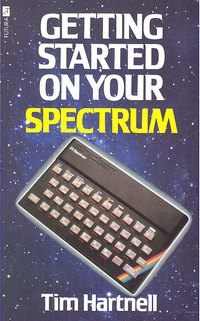 Date: July 1983
Getting Started on Your Spectrum
Date: July 1983
Getting Started on Your Spectrum
Publisher: Futura Publishing
Author: Tim Hartnell
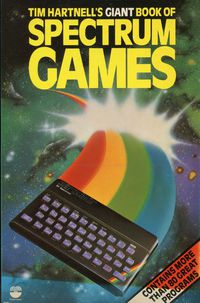 Date: 1983
Giant Book of Spectrum Games
Date: 1983
Giant Book of Spectrum Games
Contents
- Arcade Action
- Adventure
- Space Games
- Board Games
- Card Games
- Just For Fun
- Games for Thinkers
- Simulation
Appendices
- Utility & Demonstration Programs
- Games to Convert
- Error Trapping
- Glossary
Publisher: Fountain Books
Author: Tim Hartnell
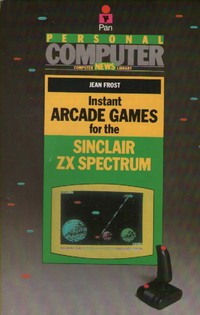 Date: 1983
Instant Arcade Games for the Sinclair ZX Spectrum
Date: 1983
Instant Arcade Games for the Sinclair ZX Spectrum
For the newcomer to computing, Jean Frost's Instant Arcade Games will be nothing short of a revelation. With little or no knowledge of BASIC, you can still take a suite of 'skeleton' programs and create your own arsenal of dynamic and totally unique arcade games. This is not just another collection of listings, but a library of software that also serve as one of the most accessible introductions to structured programming ever written. For Spectrum users who already write their own software, Instant Arcade Games offers an invaluable library of imaginative subroutines and user-defined graphics to enhance the efficiency and visual impact of their game programs. Spaceships, motherships, firing and scoring routines - the book is packed with ready-made modules that can be slotted into virtually any kind of arcade-style program.
Publisher: Pan Books
Author: Jean Frost
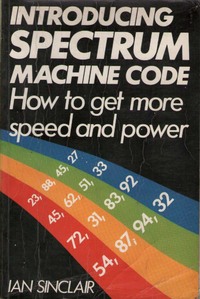 Date: 1983
Introducing Spectrum Machine Code - How To Get More Speed and Power
Date: 1983
Introducing Spectrum Machine Code - How To Get More Speed and Power
Publisher: Granada Publishing Ltd
Author: Ian Sinclair
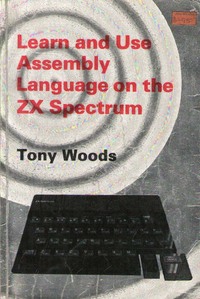 Date: 1983
Learn and Use Assembly Language on the ZX Spectrum
Date: 1983
Learn and Use Assembly Language on the ZX Spectrum
Machine code for action. Machine-code programs run very quickly, literally hundreds of times faster than the equivalent BASIC. And they are very powerful, enabling your computer to do things undreamed of by its manufacturer!
The ZX Spectrum uses a Z80 processor, and machine-code programs are written in Z80 assembly language. This book is a complete course in Z80 assembly language, right from the beginning. Written by an experienced teacher and programmer, it is ideal for anyone with a knowledge of BASIC and contains many complete-and useful- programs.
Assembly software. The assembly-language listings in this book can of course be hand assembled into machine code, but for speed and accuracy you should use the McGraw-Hill ZX Spectrum Machine Code Assembler program, available on cassette for the 16K or 48K Spectrum. All the program listings have been specially written to match this software
Publisher: McGraw Hill
Author: Tony Woods
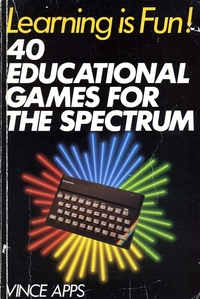 Date: 1983
Learning is Fun! 40 Educational Games for the Spectrum
Date: 1983
Learning is Fun! 40 Educational Games for the Spectrum
The programs in this book have been designed to help the younger members of your family to handle the spectrum and to increase their general knowledge- whilst enjoying themselves.
Publisher: Granda Publishing
Author: Vince Apps
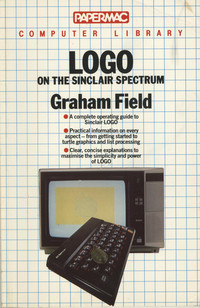 Date: 1985
LOGO on the Sinclair Spectrum
Date: 1985
LOGO on the Sinclair Spectrum
Back Cover:
LOGO is a powerful computer language which encourages clear thinking and proven problem-solving techniques. Although initially developed for use by children, LOGO is not a 'toy' langugae; it is a powerful tool which can be used to exploit the full potential of the microcomputer.....Sinclair LOGO is a full implementation of the language and provides a comprehensive range of its features... This book provides a complete guide to using LOGO on the Sinclair Spectrum.
Publisher: Macmillan
Author: Graham Field
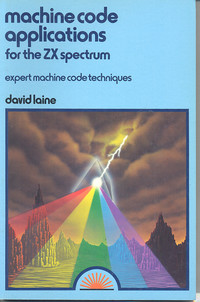 Date: 1983
Machine Code Applications for the ZX Spectrum
Date: 1983
Machine Code Applications for the ZX Spectrum
Expert machine code techniques
Publisher: Sunshine
Author: David Laine
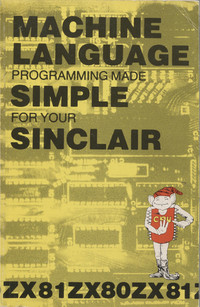 Date: 1981
Machine Language Programming Made Simple For Your Sinclair
Date: 1981
Machine Language Programming Made Simple For Your Sinclair
An introduction to machine and assembly language programming for the Sinclair ZX80 and ZX81.
Publisher: Melbourne House Publishers
Author: Beam Software
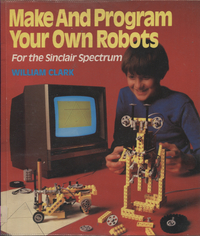 Date: 1985
Make And Program Your Own Robots
Date: 1985
Make And Program Your Own Robots
Publisher: Beaver Books
Author: William Clark
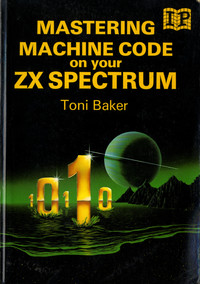 Date: 1983
Mastering Machine Code on your ZX Spectrum
Date: 1983
Mastering Machine Code on your ZX Spectrum
Publisher: Interface Publications
Author: Toni Baker
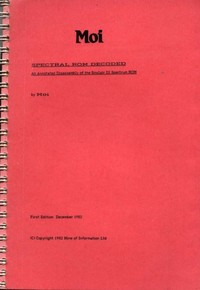 Date: December 1982
MOI Disassembly of the ZX Spectrum ROM
Date: December 1982
MOI Disassembly of the ZX Spectrum ROM
Author: David Webb
 Date: 1984
More Adventures for your ZX Spectrum
Date: 1984
More Adventures for your ZX Spectrum
Also known as "More Adventure Games for your ZX Spectrum"
Publisher: Virgin Books
Author: Clive Gifford
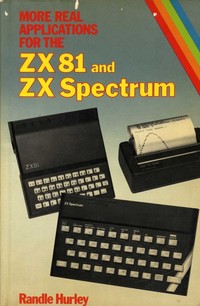 Date: 1983
More Real Applications for the ZX81 and Spectrum
Date: 1983
More Real Applications for the ZX81 and Spectrum
Publisher: The Macmillan Press
Author: Randle Hurley
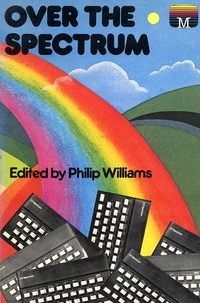 Date: 1982
Over the Spectrum
Date: 1982
Over the Spectrum
Not a teach yourself programming guide, it is a collection of programs: each program has a detailed breakdown of exactly what happens when and how its all achieved.
The listings are not trivial, and the result is well worth the effort. The book is liberally illustrated in colour showing screen displays for almost all the programs so you know what you are trying to achieve at the outset.
Publisher: Melbourne House Publishers
Author: Philip Williams
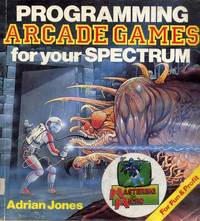 Date: 1983
Programming Arcade Games for your Spectrum
Date: 1983
Programming Arcade Games for your Spectrum
Publisher: W. Foulsham & Company Limited
Author: Adrian Jones
 Date: 1982
Programming your ZX Spectrum
Date: 1982
Programming your ZX Spectrum
From first principles to quite complex programming...more than 100 programs and routines... step by step guide to the art of programming.
Publisher: Interface Publications
Author: Tim Hartnell and Dilwyn Jones
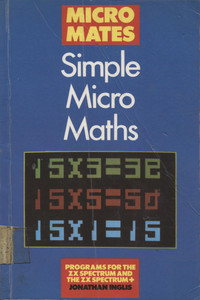 Date: 1985
Simple Micro Maths
Date: 1985
Simple Micro Maths
"Programs for the ZX Spectrum and the ZX Spectrum +"
Publisher: Granada
Author: Jonathan Inglis
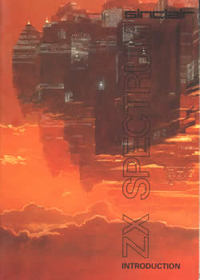 Date: 1982
Sinclair ZX Spectrum Introduction
Date: 1982
Sinclair ZX Spectrum Introduction
Sinclair ZX SPECTRUM - Introduction
Steven Vickers - Robin Bradbeer
First Edition 1982
Chapter 1 - The computer and setting it up
Chapter 2 - The keyboard
Chapter 3 - Numbers, letters and the computer as a calculator
Chapter 4 - Some simple commands
Chapter 5 - Simple programming
Chapter 6 - Using the cassette recorder
Chapter 7 - Colours
Chapter 8 - Sound
Chapter 9 - Inside the case
Signed by Ruth Bramley, Company Secretary of Sinclair Research and secretary to Sir Clive Sinclair, who was responsible for editing it.
Author: David Webb
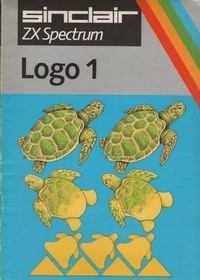 Date: 1984
Sinclair ZX Spectrum Logo 1 Turtle Graphics
Date: 1984
Sinclair ZX Spectrum Logo 1 Turtle Graphics
by Ellen Sparer
Published by Sinclair Research 1984
84 illustrated pages
This book was kindly donated by Rodney Dale
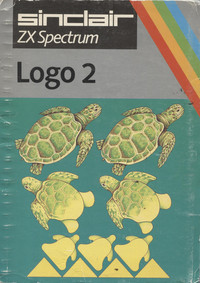 Date: 1984
Sinclair ZX Spectrum Logo 2
Date: 1984
Sinclair ZX Spectrum Logo 2
Back Cover:
Logo 2 builds upon information in Logo 1 and should not be attempted by newcomers to LOGO until Logo 1 has been read and understood.
Publisher: Sinclair Research Ltd
Author: Ellen Sparer
 Date: 1983
Sinclair ZX Spectrum Micro-PROLOG Primer
Date: 1983
Sinclair ZX Spectrum Micro-PROLOG Primer
by K L Clark, F G McCabe and J R Ennals 1983
302 pages small format paperback
Micro-PROLOG is the name of a variant or dialect of Prolog , initially created to microcomputer of 8 bits, popularized in the early of 1980 . Fue usado en la enseñanza pública, normalmente como introducción a la programación lógica ya la Inteligencia Artificial . Was used in public education, usually as an introduction to logic programming and Artificial Intelligence .
Sinclair Research launched a package that includes a 'primer' on the language, Micro Prolog, together with a cassette containing the interpreter and a few example programs. Prolog is the language that the Japanese have selected as a major component in their ambitious project for a new breed of computers called the Fifth Generation - planned for the next decade. And considering the Japanese designers are hoping to build computers that can emulate human reasoning powers, it's hardly surprising that the programming language they have chosen is a few light years away from homely old Basic.The name Prolog is derived from the phrase 'programming in logic'. The language was originally developed at the University of Marseilles about ten years ago,
This book was kindly donated by Rodney Dale
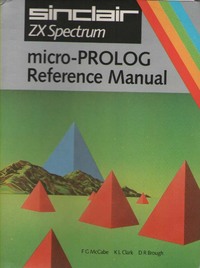 Date: 1983
Sinclair ZX Spectrum Micro-PROLOG Reference Manual
Date: 1983
Sinclair ZX Spectrum Micro-PROLOG Reference Manual
Sinclair ZX Spectrum Micro-PROLOG Reference Manual
Year of release 1983
Publisher Sinclair Research Ltd (UK)
Author(s) F.G. McCabe, K.L. Clark, D.R. Brough
Type Book: Spiral bound
ISBN 1-85016-017-1
132 pages
Micro-PROLOG is the name of a variant or dialect of Prolog , initially created to microcomputer of 8 bits, popularized in the early of 1980.
Sinclair Research launched a package that includes a 'primer' on the language, Micro Prolog, together with a cassette containing the interpreter and a few example programs. Prolog is the language that the Japanese have selected as a major component in their ambitious project for a new breed of computers called the Fifth Generation - planned for the next decade. And considering the Japanese designers are hoping to build computers that can emulate human reasoning powers, it's hardly surprising that the programming language they have chosen is a few light years away from homely old Basic.The name Prolog is derived from the phrase 'programming in logic'. The language was originally developed at the University of Marseilles about ten years ago,
This book was kindly donated by Rodney Dale
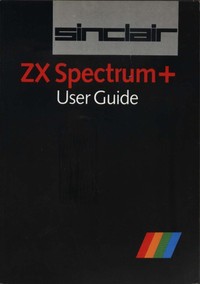 Date: 1984
Sinclair ZX Spectrum+ User Guide
Date: 1984
Sinclair ZX Spectrum+ User Guide
Sinclair ZX Spectrum+ User Guide
Author Name: Neil Ardley
Binding: paperback
Publisher: Dorling Kindesley/Sinclair Research 1984
ISBN Number: 863180809
Illustrated
82 pages
Author: David Webb
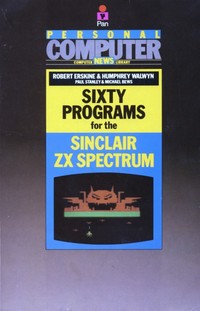 Date: 1983
Sixty Programs for the Sinclair ZX Spectrum
Date: 1983
Sixty Programs for the Sinclair ZX Spectrum
Publisher: Pan Books LTD
Author: Robert Erskine, Humphrey Walwyn, Paul Stanley, Michael Bews
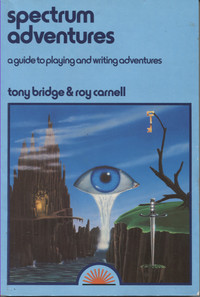 Date: 1983
Spectrum Adventures
Date: 1983
Spectrum Adventures
Publisher: Sunshine Books
Author: Tony Bridge & Roy Carnell
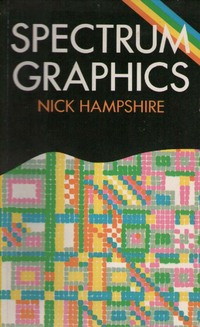 Date: 1983
Spectrum Graphics
Date: 1983
Spectrum Graphics
by Nick Hampshire
ISBN 0715617001 / 9780715617007 / 0-7156-1700-1
Publisher Duckworth & Company, Limited, Gerald
Language English
Edition Softcover
Second Impression 1983
Topics covered include:-Using color- Two dimensional shape plotting- Shape plotting- Shape scaling and stretching- Shape movement- Shape rotation- Plotting using matrix manipulation- Three dimensional shape plotting.
Spectrum Graphics is a must for every Spectrum user who wishes to use the machine to its maximum graphics display potential.
This book was kindly donated by Rodney Dale
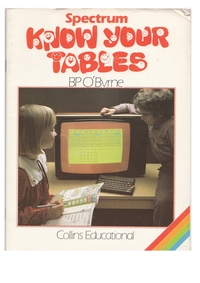 Date: 1983
Spectrum Know Your Tables
Date: 1983
Spectrum Know Your Tables
A workbook to help children learn their times tables. Originally included software of tables with practice questions included.
Publisher: Collins Educational
Author: BP O'Byrne
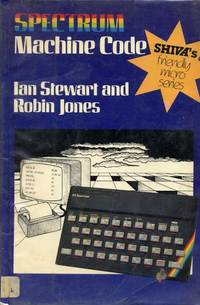 Date: 1983
Spectrum Machine Code
Date: 1983
Spectrum Machine Code
Publisher: Shiva Publishing Limited
Author: Ian Stewart and Robin Jones
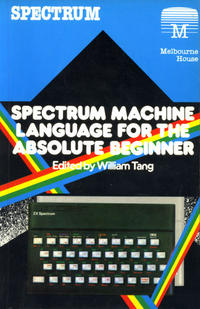 Date: 1982
Spectrum Machine Language For The Absolute Beginner
Date: 1982
Spectrum Machine Language For The Absolute Beginner
If you are frustrated by the limitations of BASIC and want to write faster, more powerful, space-saving programs or subroutines, the Spectrum Machine Language For The Absolute Beginner is the book for you.
Even with no previous experience of computer languages, you will be able to discover the ease and power of the Spectrum's own language. Each chapter includes specific examples of machine language applications which can be demonstrated and used on your Spectrum as well as a self-test questionnaire.
At the end of the book, all this is brought together in an entire machine language program - from design right through to the complete listing of an existing, original arcade game.
Publisher: Melbourne House
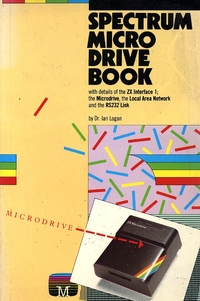 Date: 1983
Spectrum Micro Drive Book
Date: 1983
Spectrum Micro Drive Book
In this book, Dr. Ian Logan, The leading authority on Sinclair computers, gives a detailed explanation for this high speed memory storage system.
Publisher: Melbourne House Publishers
Author: Dr. Ian Logan
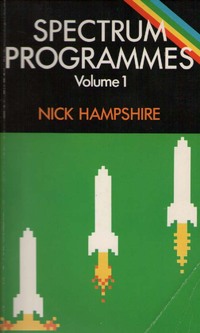 Date: 1983
Spectrum Programmes Volume 1
Date: 1983
Spectrum Programmes Volume 1
Publisher Duckworth
Author Nick Hampshire
ISBN-10 0715617044
Published 1983
182 pages + Index
This book provides the reader with a range of useful and interesting programmes for the Spectrum. Edited by Nick Hampshire, publisher for Commodore Computing International, the programme topics include:-Music-Games-Utilities-Graphics-Functional programmes, etc. Spectrum Programmes 1 is a basic book for every user of the Spectrum.
This book was kindly donated by Rodney Dale
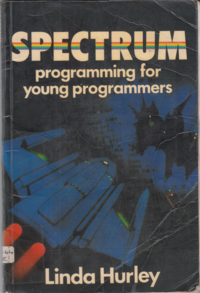 Date:
Spectrum Programming For Young Programmers
Date:
Spectrum Programming For Young Programmers
Program for action from the start!
Publisher: McGRAW-HILL Book Company
Author: Linda Hurley
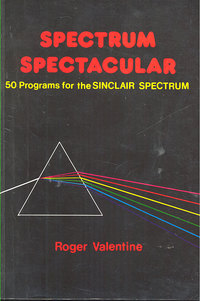 Date: November 1982
Spectrum Spectacular
Date: November 1982
Spectrum Spectacular
Spectrum Spectacular: 50 Programs for the Sinclair Spectrum
Publisher: V&H Computer Services
Author: Roger Valentine
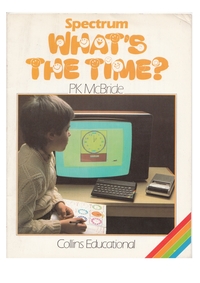 Date: 1983
Spectrum What's the Time?
Date: 1983
Spectrum What's the Time?
Children's workbook used to teach children to tell the time. Originally came with a software cassette to run on the ZX Spectrum.
Publisher: Collins Educational
Author: PK McBride
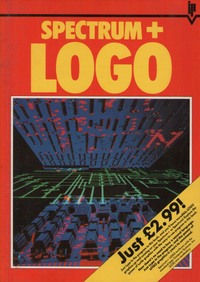 Date: April 1985
Spectrum+ LOGO
Date: April 1985
Spectrum+ LOGO
Logo-K for the Spectrum+ and Spectrum
Publisher: Interface Publications
Author: Tim Hartnell
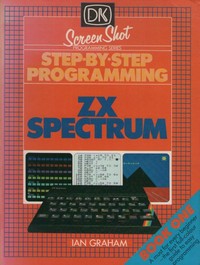 Date: 1984
Step-By-Step Programming ZX Spectrum Book One
Date: 1984
Step-By-Step Programming ZX Spectrum Book One
Publisher: Dorling Kindersley
Author: Ian Graham
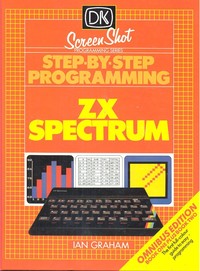 Date: 1984
Step-by-Step Programming ZX Spectrum Omnibus Edition
Date: 1984
Step-by-Step Programming ZX Spectrum Omnibus Edition
Omnibus Edition - Book One plus Book Two
Publisher: Dorling Kindersley
Author: Ian Graham
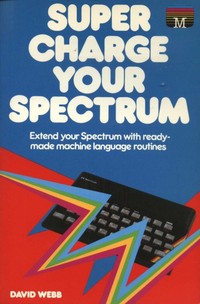 Date: 1983
Super Charge Your Spectrum
Date: 1983
Super Charge Your Spectrum
"Now without any additional effort, you can overcome the limitations of BASIC and give your Spectrum real power-faster programs, more powerful graphic commands, realistic explosions, fast screen scrolling, great sounds and much more! This book will help you to develop programs of professional quality- not only will your programs look better, run faster, and be more spectacular- but you will also be able to develop them in a fraction of the time you would expect it to take. One of the most spectacular examples of extending the Spectrum is a routine that allows you to reproduce your voice and play it back from within your own programs! No knowledge of machine language is required, as all the routines have been fully written and can be directly entered into your Spectrum. The routines in this book will also allow you to renumber your BASIC programs (including all GOTOs and GOSUBs!), deletes lines, and trace BASIC programs by showing the line number of each line as it executes. David Webb also includes the most discussion of all the Spectrum's system variables yet published. If you are already familair with machine language, then this book will be an invaluable aid to writing your own programs- here are over 50 ready-made and debugged routines, with clear and detailed comment, that use the full power of the Spectrum Z80A and its special features. So whether you are a beginner Spectrum user or an experienced programmer, Supercharge your Spectrum is a book you cannot be without."
Publisher: Melbourne House
Author: David Webb
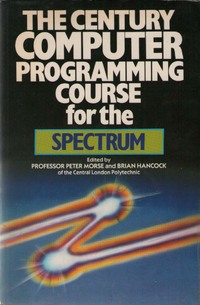 Date: 1985
The Century Computer Programming Course for the Spectrum
Date: 1985
The Century Computer Programming Course for the Spectrum
Publisher: Century Communications Ltd.
Author: Professor Peter Morse and Brian Hancock
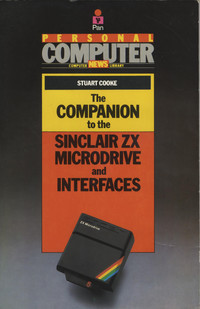 Date: 1984
The Companion to the Sinclair ZX Microdrive and Interfaces
Date: 1984
The Companion to the Sinclair ZX Microdrive and Interfaces
Back cover:
The advent of the ZX Microdrive, Interface 1 and Interface 2 has turned a toy into a tool, making the Spectrum the core of a powerful and flexible computer system. With the mass storage capacity and fast access of the Microdrive, and the control and communications facilities of Interface 1 and Interface 2, the potential is astonishing.
The Companion sets out to explain the function of all parts of the system, how they intereact with eachother, with peripherals, and via the networking facility....
Publisher: Pan Books
Author: Stuart Cooke
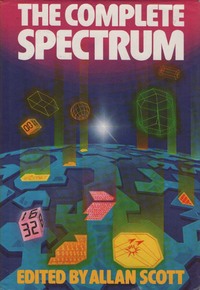 Date: 1985
The Complete Spectrum
Date: 1985
The Complete Spectrum
From the inside cover:
'The Complete Spectrum assembles the tried and tested work of a number of established authors into a step-by-step guide to mastering the Spectrum. Using this unique single-volume manual, even a complete beginner will soon learn the simple techniques he needs to create his first programs in BASIC, and can quicklty move on to more advanced work with graphics, sound, and machine code. It's a reference book, too, with a helpful guide to Spectrum-compatible hardware and software and dozens of invaluable program examples, tables, diagrams, and explanations.'
Publisher: Book Club Associates
Author: Ian Sinclair, Steve Money, Vince Apps, Mike James, S.M. Gee, Kay Ewbank & Allan Scott
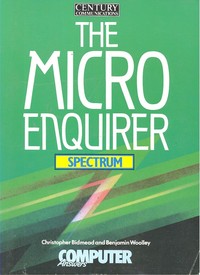 Date: 1984
The Micro Enquirer - Spectrum
Date: 1984
The Micro Enquirer - Spectrum
Publisher: Century Communications
Author: Christopher Bidmead & Benjamin Woodley
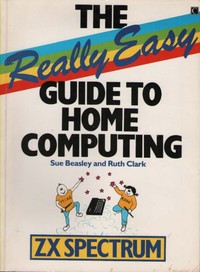 Date: 1983
The Really Easy Guide to Home Computing: The ZX Spectrum
Date: 1983
The Really Easy Guide to Home Computing: The ZX Spectrum
Classifications
Dewey Decimal Class 001.64/04
Library of Congress QA76.8.S625
ID Numbers
Open Library OL16514775M
Publisher: Century Publishing
Author: Sue Beasley and Ruth Clark
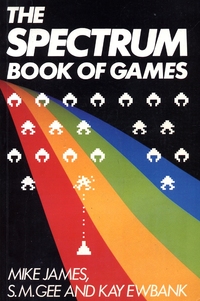 Date: 1983
The Spectrum Book of Games
Date: 1983
The Spectrum Book of Games
Here is a selection of twenty-one exciting, high quality games written specially for the ZX Spectrum. These games make full use of the Spectrum's facilities, and are fully tested and crash proof.
Publisher: Granda Publishing
Author: M. James, S. M. Gee and K. Ewbank
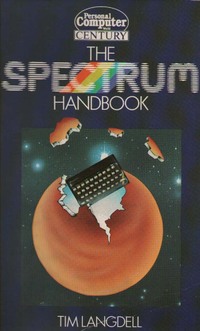 Date: 1982
The Spectrum Handbook
Date: 1982
The Spectrum Handbook
ISBN: 071260152X / 0-7126-0152-X
by Tim Langdell
Publisher: Century,
Publication Date: 1982.
Publication Place: London :
216 pages
ISBN: 071260152X (pbk)
Subject: Sinclair ZX Spectrum (Computer)
Sinclair ZX Spectrum microcomputer systems
This book was kindly donated by Rodney Dale
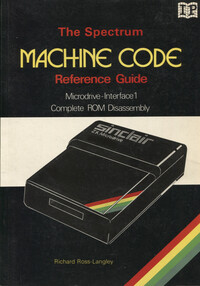 Date: 1983
The Spectrum Machine Code Reference Guide: Microdrive-Interface1 Complete ROM Disassembly
Date: 1983
The Spectrum Machine Code Reference Guide: Microdrive-Interface1 Complete ROM Disassembly
From the introduction:
'This book contains a full disassembly listing of the Sinclair ZX Spectrum 16K ROM and a machine code programmer's guide to the Microdrive & Interface 1 unit. Enough detail is included to help you, as a machine code programmer, to understand the operation of the Sinclair ZX Spectrum and its Interface 1 and to design machine code routines for your own purposes.'
Publisher: Interface Publications
Author: Richard Ross-Langley
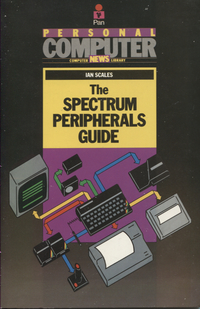 Date: 1984
The Spectrum Peripherals Guide
Date: 1984
The Spectrum Peripherals Guide
Publisher: Pan Books Ltd
Author: Ian Scales
 Date: 1983
The Spectrum Programmer
Date: 1983
The Spectrum Programmer
This book takes the Spectrum user in esy stages from his first step in programming to a good level of competence.
Publisher: Granda Publishing
Author: S. M. Gee
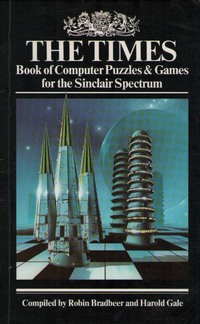 Date: 1984
The Times Book of Computer Puzzles & Games for the Sinclair Spectrum
Date: 1984
The Times Book of Computer Puzzles & Games for the Sinclair Spectrum
Sidgwick and Jackson have joined with The Times to produce this book of challenging puzzles and games to be solved and played using the Sinclair ZX Spectrum computer. Computer expert Robin Bradbeer and Harold Gale of MENSA have made their selection on the basis of their originality and entertainment value, whilst at the same time, ensuring that they are at an approachable level to appeal to as wide an audience of computer hobbyists as possible.
Publisher: Sidgwick & Jackson Ltd with Times Books Ltd
Author: Robin Bradbeer and Harold Gale
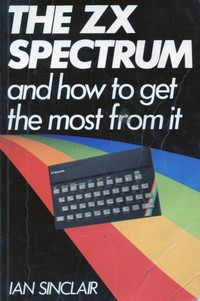 Date: 1982
The ZX Spectrum and how to get the most from it
Date: 1982
The ZX Spectrum and how to get the most from it
This book is written for the Sinclair SPECTRUM user who is a beginner or has used other machines, particularly the ZX 81. It covers the setting up and operation of the machine in detail but from the viewpoint of the beginner, highlighting the difficulties and illustrating how the machine responds to incorrect commands. The beginner is guided through the difficult early stages until he or she feels confident enough to start designing and entering BASIC programs. The book has also been designed to be used as a reference guide for the more experienced user.
Publisher: Granda Publishing
Author: Ian Sinclair
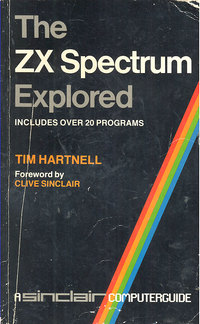 Date: 1982
The ZX Spectrum Explored
Date: 1982
The ZX Spectrum Explored
With colour, sound, up to 48K RAM and high-resolution graphics, the ZX Spectrum provides professional computing power for domestic educational and business use.
In this practical guide - with programs throughout - Tim Hartnell takes his readers from their first steps in programming to how the ZX Spectrum can be used as a tool at home, at work and for education. He looks at the use of sound, colour and 3D graphics, and shows how to write programs in BASIC, as well as how to use machine code on the ZX Spectrum.
Publisher: Sinclair Browne
Author: Tim Hartnell
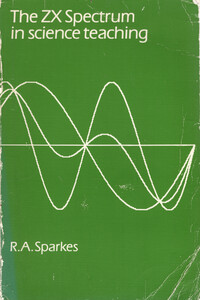 Date: 1984
The ZX Spectrum in Science Teaching
Date: 1984
The ZX Spectrum in Science Teaching
"An essential source book for science teachers who want to use the ZX Spectrum in their teaching"
Publisher: Hutchinson
Author: R.A. Sparkes
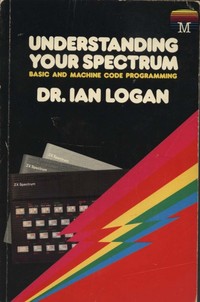 Date: 1983
Understanding Your Spectrum - Basic and Machine Code Programming
Date: 1983
Understanding Your Spectrum - Basic and Machine Code Programming
Dr. Ian Logan is widely acknowledged as the leading authority on Sinclair computers. In this book, he gives you a complete overview of the way the Spectrum operates, both for BASIC and machine language programming, including numerous demonstration programs. In Dr. Logan's word Understanding Your Spectrum has three main aims: to explain, in simple terms, how the Spectrum works; to teach Z80 machine code from the first principles; and to give details of monitor entry points, so that efficient programs can be written. A special section of the ROM operating system will give you insight into the Spectrum and provide you with information on how to use many of the routines present in the ROM in your own programming/ This book is a must if you are serious about programming the Spectrum.
Publisher: Melbourne House
Author: Ian Logan
 Date: 1984
Using the Spectrum in Education: A Guidebook for Teachers & Parents
Date: 1984
Using the Spectrum in Education: A Guidebook for Teachers & Parents
A full guide to using the Spectrum for Educational purposes, starting from describing the machine to teaching programming.
Publisher: Hartnell
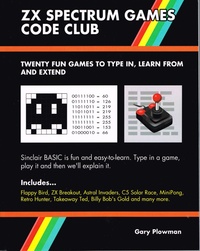 Date: 2015
ZX Spectrum Games Code Club
Date: 2015
ZX Spectrum Games Code Club
This 127-page book contains instructions for coding games on the Sinclair ZX Spectrum. It was published in 2015, 32 years after the Spectrum's release, demonstrating the machine's continuing appeal in the retro computing world. The games in the book include variants on classics like Breakout and Space Invaders, as well as versions of simple modern games like Flappy Bird.
Publisher: Gazzapper Press
Author: Gary Plowman
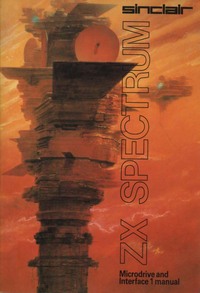 Date: 1983
ZX Spectrum Microdrive and Interface 1 Manual
Date: 1983
ZX Spectrum Microdrive and Interface 1 Manual
Manual for the Sinclair ZX Spectrum Microdrive and Interface 1.
Publisher: Sinclair Research Limited
